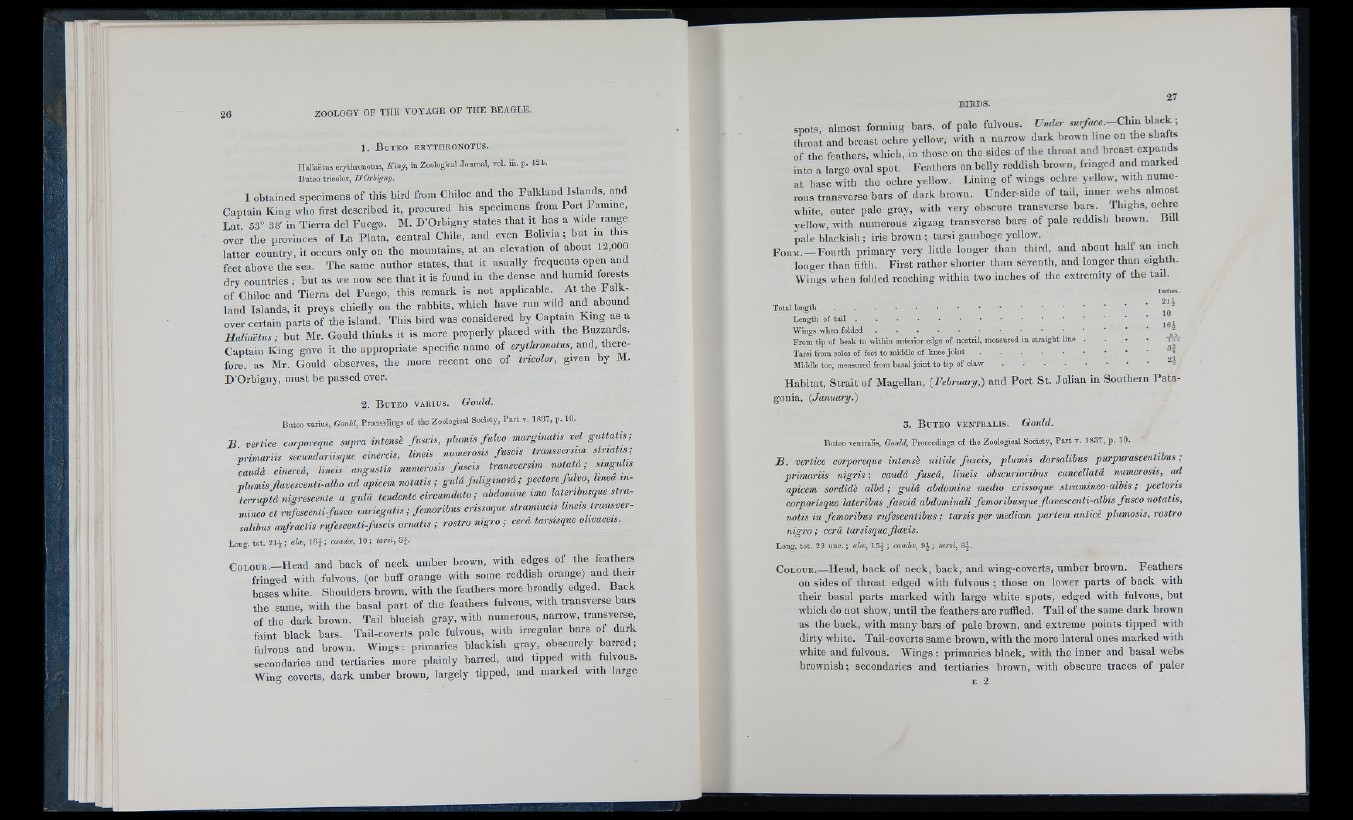
1 . B u t e o e r y t h r o n o t u s .
HiJiaetas erj-tlironotas, King, m Zoologiciil Jou n » l. vol. iii. p. iU .
Buteo tricolor, D ’Orhigny.
I obtained specimens of this bird from Chiloe and the Falkland Islands, and
Captain King who first described it, procured his specimens from Port Famine,
Lat 53° 38' ill Tieria del Fuego. M. D'Orbigny states that it has a wide range
over the provinces of La Plata, central Chile, and even Bolivia ; hut m tins
latter country, it occurs only on the mountains, at an elevation of about 12,000
feet above the sea. The same author states, that it usually frequents open and
dry countries ; but as we now see that it is found in the dense and humid forests
of Chiloe and Tierra del Fuego, this remark is not applicable. At the Falkland
Islands, it preys chiefly on the rabbits, which have run wild and abound
over certain parts of the island. This bird was considered by Captain King as a
Haliaëtus; but Mr. Gould thinks it is more properly placed with the Buzzards.
Captain King gave it the appropriate specific name of erythronotus, and therefore,
as Mr, Gould observes, the more recent one of tricolor, given by M.
D'Orbigny, must be passed over.
2 . B u t e o v a e i u s . Gould.
Buteo Tuims, Omld, Proceedings of the Zoologienl Society, P art T. 1837, p. 10.
B vértice corporeque supra intensé fuscis, plumis fulvo marginatis vel guttatis;
primariis secundariisque ciñereis, lineis numerosis fuscis transversim striatis
caudd cincred, lineis angustis numerosis fuscis transversim notatd ; singulis
plumis flavesceuti-alho ad apicem notatis; guld fuliginosd ; pectore fulvo, linea in-
terruptd nigrescente a guld tendente circumdato ; abdomine imo lateribusque stra-
mineo et rnfescenti-fuseo variegatis ; femoribus crissoque stramineis hneis transver-
salihus anfractis rufescenti-fuscis ornatis ; rostro nigro ; cera tarsisque otivaceis.
Long. tot. 21^; aloe, 16^; caudæ, 10; tarsi, 3-f.
C o l o u r . — Head and back of neck umber brown, with edges of the feathers
fringed with fulvous, (or buff orange with some reddish orange) and their
bases white. Shoulders brown, with the feathers more broadly edged. Back
the same, with the basal part of the feathers fulvous, with transverse bars
of the dark brown. Tail blueish gray, with numerous, narrow, transverse,
faint black bars. Tail-coverts pale fulvous, with irregular bars of dark
fulvous and brown. Wings; primaries blackish gray, obscurely barred;
secondaries and tertiaries more plainly barred, and tipped with fulvous.
Wing coverts, dark umber brown, largely tipped, and marked with large
BIRDS.
spots, almost forming bars, of pale fulvous. Under yar/ucc.-Chin black ;
throat and breast ochre yellow, with a narrow dark brown line on the shafts
of the feathers, which, in those on the sides of the throat and breast expands
into a large oval spot. Feathers on belly reddish brown, fringed and marked
at base with the ochre yellow. Lining of wings ochre yellow, with numerous
transverse bars of dark brown. Under-side of tail, inner webs almost
white, outer pale gray, with very obscure transverse bars. Thighs, ochre
yellow, with numerous zigzag transverse bars of pale reddish brown. Bill
pale blackish; iris brown ; tarsi gamboge yellow.
F o r m . — Fourth primary very little longer than third, and about half an inch
longer than fifth. First rather shorter than seventh, and longer than eighth.
Wings when folded reaching within two inches of the extremity of the tail.
Inches.
2li
1 straight line
10
I6è
3Î
n
Total length
Length of t a i l ........................................................................
Wings when folded
From tip of beak to within anterior edge of nostril, measured
Tarsi from soles of feet to middle of knee joint
Middle toe, measured from basal joint to tip of claw
Habitat, Strait of Magellan, {February,) and Port St. Julian in Southern Fata-
gonia, (January.)
3 . B u t e o v e n t r a l i s . Gould.
Buteo ventralis, Gould, Proceedings of the Zoological Society, P art v. 1837, p. 10*
B . vertice corporeque intensé nitide fuscis, plumis dorsalihus purpurascentihus ;
primariis nigris ; cauda fused, lineis obscurioribus cancellatd numerosis, ad
apicem sordidè albâ ; gula abdomine medio crissoque siramineo-albis ; pectoris
corporisque lateribus fascia abdominali femoribusque flavescenti-albis fusco notatis,
notis in femoribus rufescentibus ; tarsis per mediam partem anticè phimosis, rostro
nigro ; cerd tarsisque Jiavis.
Long. tot. 23 u n e .; aloe, 1 5 ^ ; caudæ, 9-J; tarsi, 8-|-.
C o l o u r .— Head, back of neck, back, and wing-coverts, umber brown. Feathers
on sides of throat edged with fulvous ; those on lower parts of back with
their basal parts marked with large white spots, edged with fulvous, but
which do not show, until the feathers are ruffled. Tail of the same dark brown
as the back, with many bars of pale brown, and extreme points tipped with
dirty white. Tail-coverts same brown, with the more lateral ones marked with
white and fulvous. Wings : primaries black, with the inner and basal webs
brownish ; secondaries and tertiaries brown, with obscure traces of paler
E 2